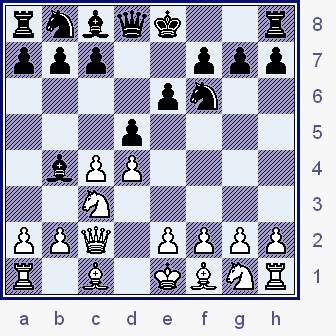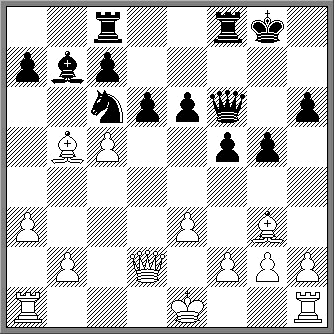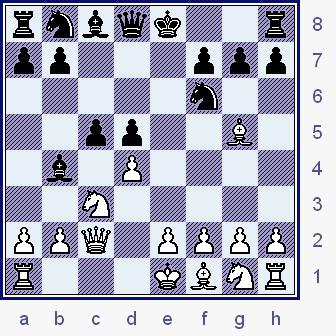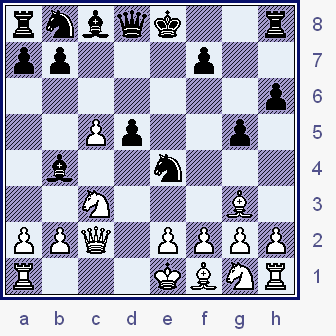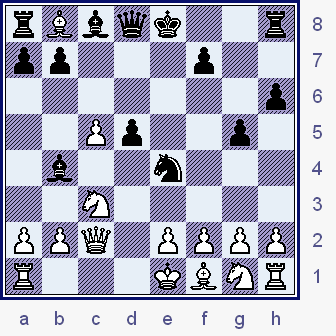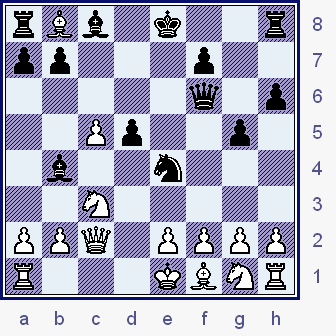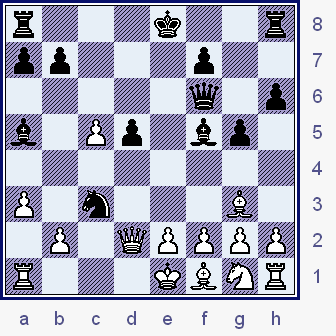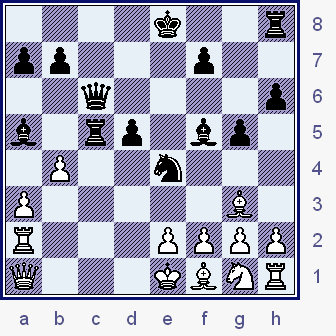All
the |
(Navigation bar
directly below.)
*******
© A.J. Goldsby, 2015.
(All rights reserved.)
****************
Click HERE
to see my
Chess Items.
****************
****************
Buy a book
from Amazon.com
(And help me out as well!)
****************
Click HERE
...
to see a list of the businesses that help to sponsor all of
my chess efforts.
"Getting Nimzo'd," Part II(A nice miniature.) |
|
Click here to see a detailed explanation of the symbols that I use when annotating a chess game. Click here to go to another site ... where you can search for this game in a "js-replayable" format. One of the principal reasons that I annotated this game ... paying such special attention to the opening ... is that I received a request, via e-mail. {Close to six months ago.} The reader in question asked for at least one game on the "Classical System" explaining that he was fairly young, (around 12 years old) - and also that he only had a couple of chess books, and none were on the openings. He went on to tell me that he was trying to make the chess team at his school, and that he wanted to see how the GM's played the White side of this opening system. (However, I want to stress that NO ONE GAME can replace good study, and that every {serious} student of chess should own at least one good openings reference work - like MCO-14!!! This should be considered a necessity!) ************************* Click
here to
see another game that I have annotated - with 4.Qc2, in this
opening system. |
GM Ivan Sokolov (2676) - GM Levon Aronian (2756)
|
|
|
[A.J.G.]
When I saw this game, I knew I had to add it to my collection. A 2676 loses in 19 moves?!???
(And with the White pieces, no less!)
The second main reason that I decided to annotate this game was that the man playing the Black pieces here is the rising young super-star, GM Levon Aronian.
** ** ** ** ** ** ** ** ** ** ** ** ** ** ** ** ** ** ** ** ** ** ** ** ** ** ** ** ** ** ** ** ** ** ** **
{The ratings are those of the world body of FIDE.}
1.d4 Nf6;
2.c4 e6;
3.Nc3 Bb4;
The Nimzo-Indian ... just one of the many creations of a great player, (Aaron Nimzowitsch); and one of the leaders of the hyper-modern movement.
Apparently - Aronian doesn't mind playing either side of this opening. And although Black wins this contest decisively, earlier in this same event, (R4; against Johannessen, rated 2559); Aronian was White ... and won a nice game in only 31 total moves.
4.Qc2,
(Trying to avoid doubled-QBP's.)
The classical line, it was first hammered into a cohesive opening system by none other than one of the greatest players who ever lived ... GM Jose Raul Capablanca.
[ The move of
4.e3,
leads to the Rubinstein System.
[See MCO-14 for more details on this very complex system.]
]
4...d5;
('!') {See the diagram below.}
Black grabs the center ... which is never a bad idea in the opening.
|
|
rnbqk2r/ppp2ppp/4pn2/3p4/1bPP4/2N5/PPQ1PPPP/R1B1KBNR w
4...c5; and 4...0-0; are also good moves, and fully playable for Black as well.
[ One of the main lines for White would be the following continuation:
4...0-0; 5.a3 Bxc3+;
Black can also keep his Bishop, (by retreating to e7); but this is
the sharpest way of playing, and it also avoids a loss of tempi.6.Qxc3 b6; 7.Bg5 Bb7; 8.f3, A solid option, guarding e4.
** ** ** ** ** ** ** ** ** ** ** ** ** ** ** ** ** ** ** ** ** ** ** ** ** ** ** ** ** **
( A bit of research turned up the following entertaining encounter:
8.e3 d6; 9.c5!?N Nc6; 10.Nf3 h6; 11.Bh4 g5; 12.Bg3 bxc5;
13.dxc5 Ne4; 14.Qc2 f5!; 15.Bb5 Rc8; 16.Nd2 Nxd2;
17.Qxd2 Qf6!; {Analysis Diagram - just below.}
This is the current situation on the chess board.
18.h4!?, (Over-aggressive?)
Ivanchuk brands this as dubious and recommends f2-f3 instead.
(The computer does not mind this that much, in fact ...
it is the first choice of some programs.)18...f4; 19.hxg5 hxg5; 20.exf4?, (The losing move.)
This looks like a good idea, but it turns out that it allows Black
too much play. However, the win is far from easy, Black must run
a dangerous gauntlet to pick up the full point.( We get a weird position after:
>/= 20.Qc2 Rf7; 21.Bh2, "~" but White is hardly lost. )20...gxf4; 21.Rh4!?, ('?!')
The computer does not like this play, but it may already be too
late to turn back ... or undo the damage that has been done.( After the continuation: 21.Bh4 Qe5+; 22.Kf1 Qxc5;
("/+") Black is {also} much better. )21...Qe5+; 22.Kf1!? fxg3; 23.Rg4+ Kf7[]; 24.Re1!? Qxc5?!;
This looks like a natural move here, but in the end, it might
actually place the win in jeopardy. (Maybe just - '?' ... or worse.)( >/= RR24...Qh5! ; "-/+" )
25.Qf4+ Ke8; 26.Rxe6+ Kd7; 27.Rg7+ Kxe6; 28.Rg6+?, ('??')
This throws away the draw.( Careful analysis with Fritz shows that White has a perpetual check,
one that Black must accept here, or risk losing outright. I.e.,
>/= 28.Bc4+ d5; 29.Qg4+, "=" and Black will have to allow a
draw by repetition. If you do not believe me, I suggest you fire
up your favorite program ... and work it out for yourself.
(Alas - Giese found this first, well ahead of me.) )Now Black can go to d5 ... which wins, (as in the game).
Instead, White misses a 2nd chance to draw this one.28...Kd7?!; 29.Rg7+ Ke6; 30.Rg6+? Kd5!; 31.Qd2+ Qd4!!;
Black now has figured out the exact path to the win.32.Bxc6+! Kxc6!; Very nice. (Black avoids a calamity.)
( But definitely not:
</= 32...Bxc6?; 33.Rg5+ Kc4??; 34.Qc2+, "+/-"
and its mate next move. )33.Qxd4 Ba6+!; "-/+"
The sting at the end of the scorpion's tail, Sokolov resigns, as a
King move allows ...gxf2+; and Black gets a new Queen next move.GM I. Sokolov - GM V. Ivanchuk; / ICT, Hoogoven's Masters
Wijk aan Zee; NED; (R6) / 1996.This game has been annotated in many places, see Informant # 65.
(See also 'Chess Life,' R. Byrne's column in the June 1996 issue.
And I believe that GM L. Ftacnik annotated this one for CB.)I redid this game ... mainly because the annotators have pointed to all
the wrong places as the cause(s) for Black's downfall. )** ** ** ** ** ** ** ** ** ** ** ** ** ** ** ** ** ** ** ** ** ** ** ** ** ** ** ** ** **
8...h6; 9.Bh4 d5!; {Diagram?}
(To prevent White from playing e2-e4, owning the whole center.)10.e3, "+/=" 10...Nbd7;
Whiter has a slight edge in this position, but Black's game is both
solid and playable here.A good example of this would be:
GM Vladimir Kramnik (2770) - GM Garry Kasparov (2849); [E32]
The "Brain Games" (BGN) World Chess Championships (match)
/ London, ENG; (G #8), 08,10,2000. {A well-played draw in 38 moves.}[ For more information (& analysis) on these lines, please see MCO-14,
(start on page 528); columns no. One through eighteen, and all notes.
(This analysis matches column # 01 on page # 532, esp. see note # g.) ] ]
5.cxd5,
('!?')
This is the most commonly played move here, but one has to wonder if it is really the best continuation. (This exchange seems to greatly ease Black's game, maybe White would be better off to simply try and continue with his development.)
[ Maybe White should simply play:
(>/=) 5.Nf3 Nc6; 6.e3 0-0; "="
but Black does not appear to have any real problems here.
(However, White has won a high number of the games in the
db, see Kurajica - Mitkov; 1995 ... as one of the higher-rated
examples of the contests that arise from the variation quoted
above.)***********************************************************************************
Perhaps this game is a good reason why the "book" line here is:
(>/=) 5.a3 Bxc3+!?; 6.Qxc3 Ne4; "<=>"
but Black has a good position here and active play as well.[ See MCO-14, page # 535; column # 07, and all notes that
pertain to these lines. ]One of the most accurately played games in this line would have to be:
GM Garry Kasparov (2813) - GM Michael Adams (2740);
ICT, The 20th European Cup, (EUCup 20th) / {An exciting draw.}
Izmir, TUR; (R#5) / 07,10,2004. ]
5...exd5;
6.Bg5 c5!?; {See
the diagram - just below.}
This is a very energetic approach, yet it seems to lead to a solid edge for White.
(The 'box' really likes White's side of the board here.)
|
|
rnbqk2r/pp3ppp/5n2/2pp2B1/1b1P4/2N5/PPQ1PPPP/R3KBNR w
Now Black must play a gambit ... it is not clear if he can get the Pawn back or not. However, for the price of one point, Aronian steals the initiative from his opponent ... ... ...
[ More "normal" ... (if you can even use this term when examining such bizarre
variations); would be:
6...h6; 7.Bxf6 Qxf6;
8.a3 Bxc3+; 9.Qxc3 0-0;
10.e3 c6; 11.Nf3,
"~" when White might have a tiny edge here, but this
position looks to be relatively balanced.
GM Anatoly Karpov (2780) - GM Judit Polgar (2630);
[E35]
ICT, Fourth
(# 4) Melody
Amber, {rapid} / Monte
Carlo, (R8) 03,1995.
(1-0, 43
moves.)
[ See (also) MCO-14, page # 535; column # 12, and all relevant notes. ] ]
Now Black goes on the offensive.
(One is reminded of a famous game here. It was in a Nimzo-Indian, Paul Keres was White, and the great Mikhail Botvinnik was Black - the second player won in a pretty convincing fashion.)
What follows now is all a 'book' line, Black tries to play as actively as he possibly can.
7.dxc5 h6;
8.Bh4 g5;
9.Bg3 Ne4; {See the
diagram given - just below.}
This is the current situation that we have on the board - it is one of tremendous imbalance.
|
|
rnbqk2r/pp3p2/7p/2Pp2p1/1b2n3/2N3B1/PPQ1PPPP/R3KBNR w
Many programs {greatly} favor White, yet the second player has won a lot of the games - that are in the database - that arise from this particular variation.
*** *** *** *** *** *** *** *** *** *** *** *** *** *** *** *** *** *** *** *** *** *** *** *** ***
It is the first player's turn to move in this position, which move would you play here? (That is, if you were playing this position for White.)
10.Bxb8!?,
{See the
diagram given - just below.}
I don't know about this move ... there are many tries that look a little better. (Why not 10.Be5,
which appears to be White's most natural play here?)
|
|
rBbqk2r/pp3p2/7p/2Pp2p1/1b2n3/2N5/PPQ1PPPP/R3KBNR b
There are less than ten games in the (on-line) database here ...
{Where White played 10.Bxb8!?}
Of course, there is a simple tactic here, if (now) 10...RxB/b8??;
...
then 11.Qa4+, will win the Black Bishop on b4.
[ The 'book line' here is to play:
(>/=)
10.e3,
"+/=" {Diag?}
when this position seems to yield White a very small edge.
One example would have to be:
GM Garry Kasparov (2805) - GM Nigel Short (2655);
/
(PCA) World Championship,
(Game # 9) / London, ENG; 1993.
{White won a long, tough struggle; 1-0 in 52
moves.}
]
10...Qf6!;
(TN) {See
the diagram given - just below.}
Apparently this is a new move for Black ... I don't think it should win by force ...
but apparently Sokolov never overcame the shock of being the "victim" of Aronian's novelty.
(Does it deserve two exclams here?)
|
|
rBb1k2r/pp3p2/5q1p/2Pp2p1/1b2n3/2N5/PPQ1PPPP/R3KBNR w
White can retreat his Bishop ... and maintain a healthy edge. (Which is exactly what GM I. Sokolov now proceeds to do.) But given the course of this game, I wonder if Ivan ever overcame the shock of being on the receiving end of this novelty?
[ One has to wonder ... GM Sokolov must have been
expecting a continuation something like:
10...Bxc3+!?;
11.bxc3 Rxb8; 12.e3 Qa5; "~"
when Black had just enough play
to hold the balance here.
GM Mihail Kobalia
(2644)
- GM Csaba Balogh
(2531);
/ ICT, Sixth European
Champion (EU-ch 6th); {Drawn,
1/2 in 35 moves.}
/
Warsaw, POL; (R8) / 18,06,2005.
Note - Balogh
is a very young player, only 19 or 20 years old. He probably
has not been a GM for very long, and he may not have (yet) achieved his
title when this game was played.
]
11.Bg3,
(Is this best?)
This is the first choice of the computer ... but it is not the only possible line here.
(The Q-check on a4 looked plausible, and I am sure that Sokolov must have spent some time analyzing this variation as well.)
[ The continuation of:
</= 11.Qa4+?! Bd7; 12.Qxb4 Qxf2+;
13.Kd1 Qxf1+;
14.Kc2 Qxa1,
"=/+" is very wild ... but appears to favor Black.
(Fritz and ChessMaster)
]
11...Nxc3;
12.a3, {Box?}
Now this move is pretty much forced here ... and the only way to avoid a disaster.
[ Instead, after the moves of:
</= 12.bxc3?? Bxc3+; 13.Kd1 Bxa1;
"-/+"
White is completely lost. ]
12...Bf5!;
13.Qd2 Ba5; ('!') {See
the diagram given - just below.}
Black has pursued his initiative as best he could, psychologically speaking, it is probably easier to play Aronian's side of the board.
|
|
r3k2r/pp3p2/5q1p/b1Pp1bp1/8/P1n3B1/1P1QPPPP/R3KBNR w
This is the current situation.
*** *** *** *** *** *** *** *** *** *** *** *** *** *** *** *** *** *** *** *** *** *** *** *** ***
It is White's turn to move in this position - what is the correct path that GM I. Sokolov should
take from here?
14.b4?,
(Maybe even - '??')
At this level, this move has to be considered a blunder ... one errant play, and a game where White held a decided edge here ... is turned into a dead lost position. (A pity.)
[ The correct continuation would have been:
>/= 14.e3 0-0;
15.b4 Ne4;
16.Qd4 Qxd4;
17.exd4 Rfe8; 18.Ne2,
'±' 18...Bd8;
"~" {Diag?}
when White has a large edge ... (and an extra button); but Black has
some play. {"Compensation,"
or 'comp' as it is sometimes called.} ]
14...Ne4;
('!')
15.Qc1[] Rc8!!;
A nice move ... adding a great deal of pressure onto his opponent.
(Did Sokolov miss this clever play?)
[ Instead after the moves: </=
15...Bd8!?;
('?!') 16.e3,
"+/=" ('±')
and White looks OK here. ]
16.Ra2?!,
(Hmmm.)
This is ugly ... and Black's edge literally quadruples after this move.
(Good or bad, White had to play 16.e3[],
{or Bd6}
and then just pray ...)
[ Much worse was the continuation:
</=
16.bxa5? Rxc5; 17.Qb1?! Qc3+;
with a mate (on d2) next move.
************************************************************************************
Also bad for White was: </=
16.e3? Rxc5; 17.Qb1?! Qc3+;
18.Ke2 Bg4+!;
"-/+" and mate on d2 next move. ]
Now Aronian takes advantage of the fact that c5 is really unprotected in this position -
as the pawn (on b4) is pinned to the White King.
16...Rxc5!;
17.Qa1!?,
This is practically forced here, I don't know what else White could do at this point. (Fritz wants to surrender the Queen ... but that line looks
pointless {to me}.)
[ The other variations were without any real hope for White.
For example:
(Var. # 17W01.)
17.Rc2? Rxc2; 18.Qxc2 Qa1+; 19.Qd1 Qc3+; "-/+"
and mate next move.*******************************************************************************
(Var. # 17W02.)
17.Qe3!? Rc3!; "-/+" and White's Queen is lost.
(There is no need for further analysis, Fritz says White
is winning by 15-20 points here.)*******************************************************************************
(Var. # 17W03.)
17.Qxc5 Nxc5; 18.Nf3 Qc3+; 19.Rd2 Ne4; "-/+" {D?}
which is also a decisive win for Black from this position. ]
17...Qc6!;
{See the diagram
... just below.}
I am sure that Sokolov must have been counting on his Qa1 move to hold his game together,
but now Aronian hits him with another big tactical shot. (Maybe - '!!')
|
|
4k2r/pp3p2/2q4p/b1rp1bp1/1P2n3/P5B1/R3PPPP/Q3KBNR w
Just about all of my friends at the chess club wanted to play the Queen along the diagonal here - or check on c3 at this point - but GM Aronian finds a move that is significantly stronger. (The threat of 18...Rc1+ is hard for White to meet.)
Of course, Black's move has a lot of "shock power," i.e., ...
a Black Rook has been left hanging on the h8-square ... ... ...
... and White can capture it ... WITH CHECK!!
18.Qe5+!?,
I guess it does not really matter at this point, by now I am sure that GM I. Sokolov was beginning to feel like a heavy bag that his opponent used to get a workout.
[ Instead ... after the following moves:
18.Kd1 Qa4+;
19.Ke1 Bxb4+!;
20.axb4 Qxb4+!; 21.Kd1 Qb3+!;
22.Ke1 Qxa2!;
("-/+")
and White is quite helpless here. ]
18...Kd8!?;
This wins easily, but Fritz seems to <think> that 18...Be6!; is a much stronger play for Black.
[ Instead, after the moves of:
>/= 18...Be6!; 19.Qb8+
Kd7!; "-/+"
(which is similar to the game); and
White would have to resign, as taking the Rook on h8 is met by ...Rc1#.
]
19.Qxh8+ Kd7;
"-/+" White Resigns.
GM Ivan Sokolov decides that it is time to quit ... as Fritz now demonstrates that White cannot avoid a certain mate.
[
White can play "give-away," or suicide chess, but that has never really
appealed to me. After
20.e3,
there follows 20...Rc1+;
21.Ke2 Bg4+!;
and no matter what move White plays here, the simple
22...Qc4# (mate)
{next move} cannot be
stopped. ]
A nice game by Aronian, but I have a hunch that this whole line was a trap, that was prepared beforehand, and caught poor GM Sokolov completely by surprise.
Copyright (c) A.J. Goldsby, 2006. All rights reserved.
0 - 1
The analysis for this page was prepared with the excellent programs, ChessBase 8.0 and ChessBase 9.0.
The HTML was polished with several different tools and programs, (mostly FP) ... the text was checked for spelling with MS Word.
The diagrams were created with the program, Chess Captor 2.25.
Click HERE to - go to or return - to my HOME PAGE ... for this site.
Click HERE to go (or return) to my site map (page).
Click HERE to go to my "Annotated Games II" (page).
Click
HERE to go (or
return) to my {2nd} main page on
miniatures / or "Best Short Games," (Vol. IV.)
(Or you could use the "Back
Button" on your web browser.)
Copyright (c) LM A.J. Goldsby I
Copyright (©) A.J. Goldsby, 2011. All rights reserved.
*******
This page was created in June, 2006. It was posted: 06/10/2006. It was last updated on: July 14, 2012 02:16 AM .
